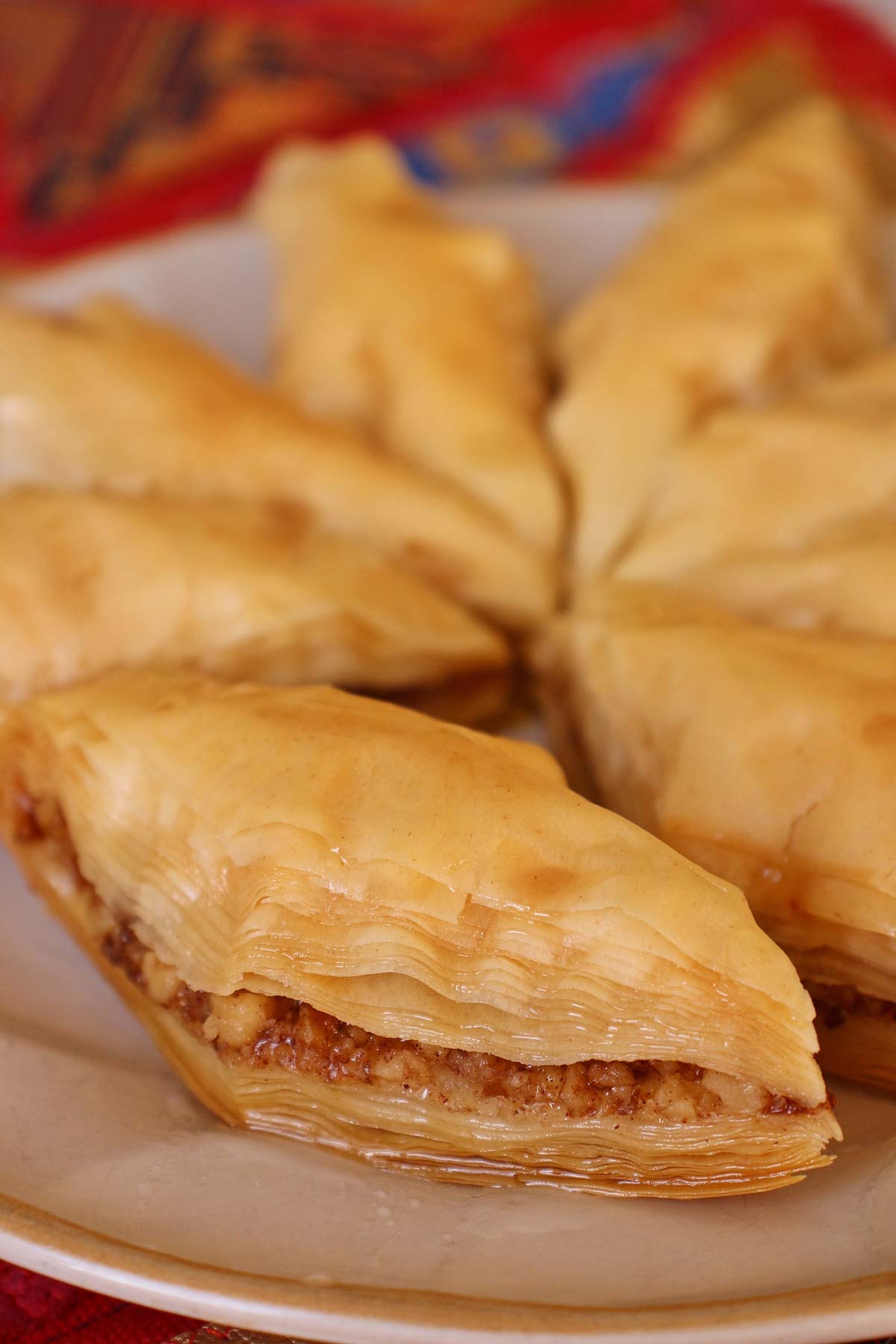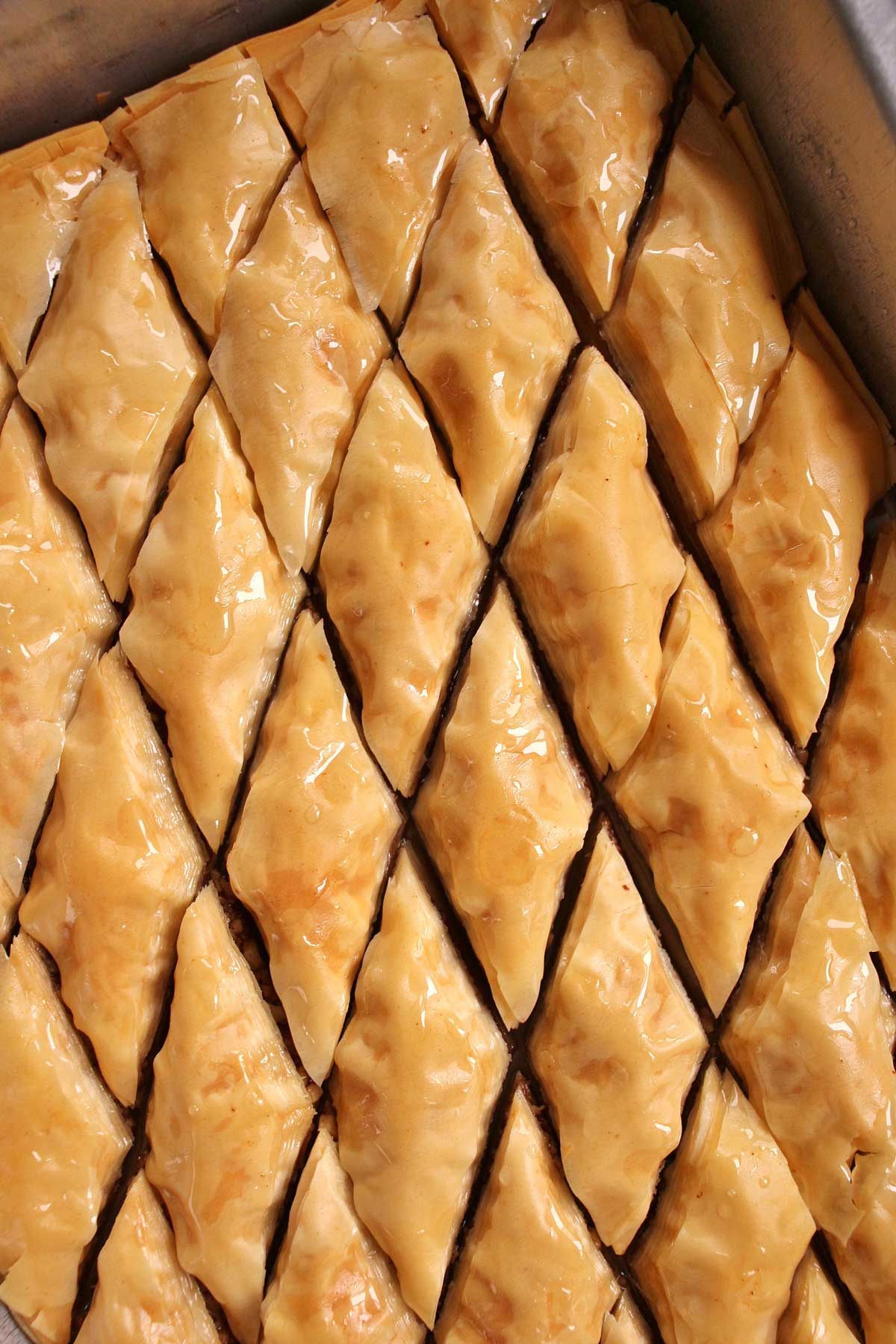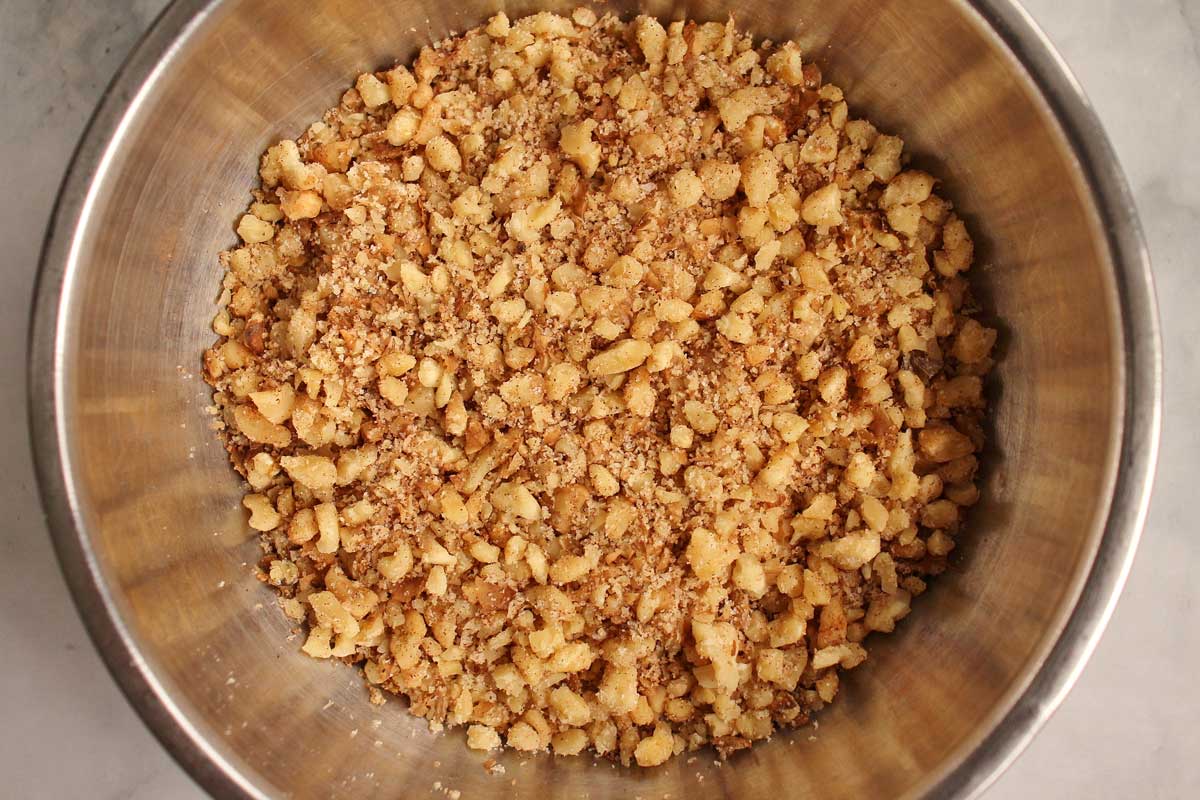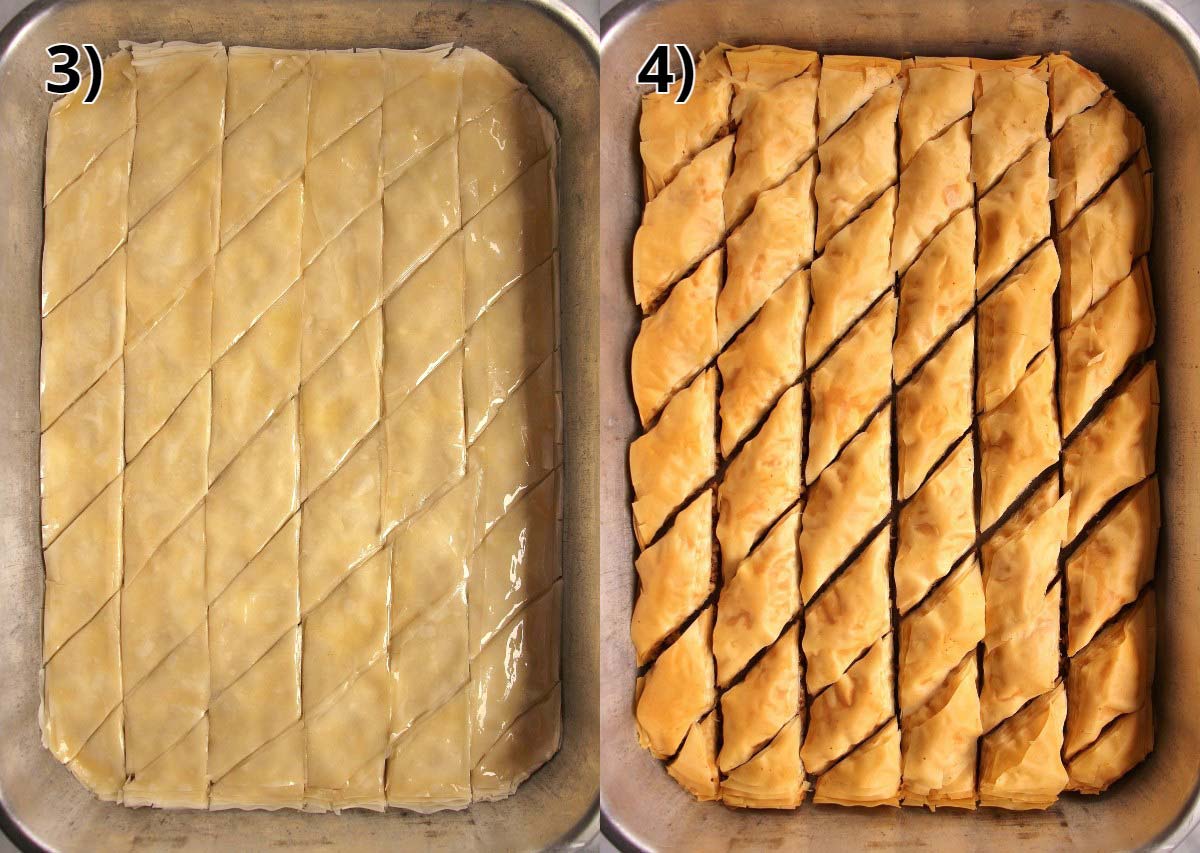Paklava (Armenian baklava) features flaky, buttery layers of phyllo dough, a filling of cinnamon-spiced chopped walnuts, and an utterly addictive clove-infused syrup. It differs from Greek baklava in how it is sweetened, and is a constant on the Armenian Christmas dessert table.

(This Armenian baklava recipe was originally published in December 2009, but was updated with new photos and content in 2020. The other 2 recipes which were previously in this post each have their own posts now: Sari Burma and Kadaif).
Baklava is a classic Middle Eastern and Mediterranean dessert featuring phyllo dough layered around a nut filling. There are many variations depending on its regional origin. For example, the main difference between Greek baklava and Armenian baklava is its sweetener. Also, Armenians pronounce it paklava (pakhlava) with a "p" sound.
While the Greek version uses honey syrup, we Armenians use a spice-infused sugar syrup to sweeten ours. We use whole cloves to flavor our syrup although some folks also use a cinnamon stick. My family finds there is enough cinnamon in the filling that the syrup does not need it as well.
We typically make our paklava leading up to Christmas and then share it with our friends and neighbors as edible holiday gifts. It truly isn’t an Armenian Christmas without a batch of sticky, sweet, nutty paklava for dessert! We often make a double batch of this recipe, and I include notes on how to do this in my tips below.
Ingredient notes

- Phyllo/Fillo Dough:
- These paper thin sheets of pastry dough can be spelled either phyllo or fillo. They are typically sold in 1 pound packages and are available in many grocery store frozen food sections.
- The most popular brands you’ll find on the market include Kontos, Athens, Apollo, and The Fillo Factory.
- Additionally, there are different thicknesses of phyllo dough sheets. The #4 is the thinnest one on the market and the one we use and recommend. It yields ideal results for various recipes. Next is #7 which is a bit thicker and good for beginners. You’ll have less sheets per 1 pound box if you use #7. There is also a #10 country style phyllo which is even thicker with even less sheets per pound box.
- Some brands offer different dimensions of phyllo dough depending on the thickness, but the most common dimensions for phyllo dough sheets is 14-by-18-inches. This is what we use for the paklava.
- Phyllo dough is typically sold frozen. Place your box of phyllo in the refrigerator overnight to gently thaw it before using.
- Clarified Butter: It is important to use clarified butter rather than regular melted butter. Butter contains fat, water, and milk proteins, but you want to isolate the butterfat only to brush on your phyllo. If you don’t do this, your layers will not be as flaky and golden. Also you will end up with dark, burned-looking specks which are the bits of milk protein browning on your paklava surface. You can clarify butter yourself (I include instructions in my tips below) or purchase ghee (clarified butter). If you use store-bought ghee, reduce the amount of butter in the recipe to about 4 ½ ounces (by weight) to make up for the evaporation of water and skimming of milk solids.
- Walnuts: You can use other nuts to fill your paklava, but we always use walnuts only. You can chop them by hand into roughly ¼-inch pieces, pulse them in a food processor, or use a nut chopper which is what we have used for years for making our paklava.
- Sugar: Plain white granulated sugar is best for sweetening your walnut filling and making the sugar syrup.
- Lemon Juice: This serves a very important purpose in making the syrup. Believe it or not it’s not simply for flavor. When boiling the sugar and water together for your syrup it will be quite cloudy. The moment you add the lemon juice you’ll see the mixture becomes clear. The lemon juice helps clarify your syrup and prevent it from crystalizing. Do not skip it!

How to make it
Prepare the filling by mixing together chopped walnuts, sugar and ground cinnamon.

Open the package of phyllo dough and lay it out on the table or a clean work surface. Cover with a clean cloth when not using it so it doesn't dry out. Take one sheet of phyllo and fold it to fit the inside of a greased 9-by-13-inch pan (it may not be folded exactly in half in order to fit). Lightly brush/blot with melted clarified butter.
Repeat with another sheet of phyllo, but this time place the folded sheet facing the other way so you alternate directions of where the dough is folded. Again, blot with butter and continue like this until half the dough is arranged in the pan (PHOTO 1). The box will tell you approximately how many sheets it contains, but feel free to count it to be more exact on when to stop. Spread the walnut filling evenly over the dough (PHOTO 2).

Continue folding and arranging the phyllo as above until you reach the last layer. For the last layer while the sheet is still on your work surface brush the dough lightly with clarified butter before folding it (so there is butter in the middle), then carefully flip it over and place it in the pan so the top is a smooth sheet of dough and the uneven folded part is hidden underneath.
Cut diamonds with a very sharp knife by cutting lengthwise into 1 ½ inch wide strips, and then start at one corner with 45° diagonals spaced about 2 inches apart until you make diamond shapes with the whole pan.
Spoon the remaining hot clarified butter evenly over the top, using the back of the spoon to gently spread the butter, if needed, without disturbing the top layer of phyllo (PHOTO 3). Bake your Armenian baklava for about 45 to 55 minutes until golden brown. Cool completely (PHOTO 4).

Prepare the syrup by dissolving sugar and water over high heat (PHOTO 5). Bring to a boil then add the lemon juice and cloves (PHOTO 6).

Lower the heat and simmer for about 10 minutes. Remove from the heat and rest for about 17 or 18 minutes until the syrup is warm, but not too hot (about 160 to 165°F).
Discard the cloves and ladle the very warm syrup over the pan of paklava and let it soak until mostly absorbed, about 1 hour. Most of the syrup should soak into the dough.
Use a sharp knife and go over all the previous cuts, making sure the paklava is cut all the way through before serving.
Please scroll to the bottom of the post for the full recipe (in a printable recipe card) including ingredient amounts and detailed instructions.

Expert tips and FAQ
Paklava has a long shelf life. Store it in an airtight container at room temperature for up to 2 weeks. I do not recommend refrigerating it as it will change the texture considerably. We will often place individual pieces of paklava onto cupcake liners for a pretty presentation but also ease of transfer to serving platters, etc.
Be gentle when working with phyllo dough, as it can tear easily. It can also quickly dry out so it is imperative to keep your phyllo covered with a cloth when not working with it.
Some boxes of phyllo may contain torn or cracked sheets. If possible, use these lesser quality sheets as the bottom layers of your paklava and save the most intact ones for the top. If the sheets in the middle of the phyllo pile are the best, you can very carefully flip over the entire pile on your work surface halfway through the process. This will ensure those middle sheets go on top of your paklava assembly for a prettier finish.
Blot the clarified butter with a pastry brush rather than brushing it. This will still ensure even coverage without overdoing it and will also be a gentler way to apply the butter to the dough without the risk of tearing it.
It is very important that the paklava and syrup are 2 different temperatures. Some people pour cold syrup over hot paklava but we always do the opposite with cooled paklava and hot syrup. If both are hot, the result will be mushy. If they are both cold, the syrup won't soak into the paklava at all.
You can easily double this recipe to use 2 pounds of phyllo dough. Use a half sheet pan (about 12-by-17-inches), arrange 1 pound of dough in the pan (only folding over excess rather than folding sheets in half-ish) doing 2 sheets at a time before brushing/blotting with butter. Then add the filling and finish with the 2nd pound of dough. For the last 4 or 5 sheets instead of brushing with butter every 2 sheets, brush between every single sheet to make sure the top few layers are nicely adhered together by butter.
The edges in a half sheet pan may seem short but they are tall enough for the height of the paklava. We double this recipe often and always use a half sheet pan.

No, they are not the same and they are not usually interchangeable. Phyllo dough (also spelled fillo or filo) comes from the Greek word meaning "leaf." They are paper-thin sheets of dough made mostly of flour and water, and are typically layered or wrapped around fillings to create layers of crispy, flaky dough when baked. Puff pastry is made by laminating dough and butter together. This entails wrapping a giant square of cold butter with dough and then folding, rolling, and chilling repetitively to create alternating butter and dough layers. When baked it puffs up to produce separate flaky layers and a crunchy exterior.
Add unsalted butter to a saucepan. Melt it over medium-low heat without stirring it (you want the components of water, fat, and milk solids to separate without disturbance). The butter will begin to boil and milk proteins will form a white layer on the surface (PHOTO 1). It’s actually the water in the butter that is boiling, not the butterfat. You want to continue to cook the butter until all of the water has gently boiled off. You’ll notice the boiling itself will calm down as the water content diminishes.
Remove from the heat and use a spoon to skim off all the white milk solids floating on the surface, and discard (it’s easier to skim it without disturbing the layers once it’s no longer actively bubbling) (PHOTO 2). Now you can use the clarified butter, which is the pure butterfat. If you notice any white milky liquid on the bottom, that is residual water that hasn’t boiled off. Just use the yellow fat and stop once you hit the white watery residue at the bottom.

Other recipes you may like
- Sari Burma (Burma Baklava/Rolled Baklava)
- Kadaif or Kadayif (Ricotta Cheese Kunafa)
- Qatayef Asafiri (Middle Eastern Cream Filled Pancakes)
- Armenian Gata
- Chorek (Armenian Sweet Bread)
- Russian Pirog with Apricot Preserves
- Browse all Armenian and Middle Eastern Recipes
Tried this recipe? Please leave a star ⭐️⭐️⭐️⭐️⭐️ rating in the recipe card below and/or a review in the comments section further down the page. You can also follow me on social media on Facebook, Instagram, and Pinterest!

Paklava (Armenian Baklava)
Ingredients
- 1 pound (454 grams) phyllo (fillo) dough (approximately 14-by-18-inch; preferably #4 thickness) defrosted in the refrigerator overnight
- 6 ounces (1 ½ sticks / 170 grams) unsalted butter, melted and clarified
Filling:
- 4 ounces (113 grams) walnuts, finely chopped (1 cup chopped)
- 1 ½ tablespoons granulated sugar
- ¾ teaspoon ground cinnamon
Syrup:
- 2 cups (400 grams) granulated sugar
- ¾ cup water
- 1 tablespoon lemon juice
- 5 whole cloves
Instructions
- Preheat oven to 350°F. Grease a 9-by-13-inch pan (see Notes below if doubling recipe).
- Prepare the filling by mixing together the walnuts, sugar and cinnamon. Set aside.
- Open the package of phyllo dough and lay it out on the table or a clean work surface. Cover with a clean cloth when not using it so it doesn't dry out. Take one sheet of phyllo and fold it to fit the inside of the pan (it may not be folded exactly in half in order to fit). Lightly brush/blot with melted clarified butter.
- Repeat with another sheet of phyllo, but this time place the folded sheet facing the other way so you alternate directions of where the dough is folded. Again, blot with butter and continue like this until half the dough is arranged in the pan. The box will tell you approximately how many sheets it contains, but feel free to count it to be more exact on when to stop.
- Spread the filling evenly over the dough. Continue folding and arranging the phyllo as above until you reach the last layer. For the last layer while the sheet is still on your work surface brush the dough lightly with clarified butter before folding it (so there is butter in the middle), then carefully flip it over and place it in the pan so the top is a smooth sheet of dough and the uneven folded part is hidden underneath.
- Cut diamonds with a very sharp knife by cutting lengthwise into 1 ½ inch wide strips, and then start at one corner with 45° diagonals spaced about 2 inches apart until you make diamond shapes with the whole pan.
- Spoon the remaining hot clarified butter evenly over the top, using the back of the spoon to gently spread the butter, if needed, without disturbing the top layer of phyllo.
- Bake for about 45 to 55 minutes until golden brown. Cool completely before moving on.
- Prepare the syrup by dissolving the sugar in the water over high heat. Bring to a boil then add the lemon juice and cloves, lower the heat and simmer for about 10 minutes. Remove from the heat and rest for about 17 or 18 minutes until the syrup is warm, but not too hot (about 160 to 165°F).
- Discard the cloves and ladle the very warm syrup over the pan of paklava and let it soak until mostly absorbed, about 1 hour. There may still be some syrup left in the pan, but most of it should soak into the dough. Use a sharp knife and go over all the previous cuts, making sure the paklava is cut all the way through before serving. Store at room temperature.
Notes
- You can easily double this recipe to use 2 pounds of phyllo dough. Use a half sheet pan (about 12-by-17-inches), arrange 1 pound of dough in the pan (only folding over excess rather than folding sheets in half-ish) doing 2 sheets at a time before brushing/blotting with butter. Then add the filling and finish with the 2nd pound of dough. For the last 4 or 5 sheets instead of brushing with butter every 2 sheets, brush between every single sheet to make sure the top few layers are nicely adhered together by butter. The edges in a half sheet pan may seem short but they are tall enough for the height of the paklava. We double this recipe often and always use a half sheet pan.
- If you are a bit too generous with the clarified butter while assembling the paklava and don't have enough left to spoon over the top, clarify another ½ stick of butter to ensure you have enough for the top. It's very important that the top is thoroughly covered in clarified butter.
- Blot the clarified butter with a pastry brush rather than brushing it. This will still ensure even coverage without overdoing it and will also be a gentler way to apply the butter to the dough without the risk of tearing it.
- If you use store-bought ghee (clarified butter), reduce the amount of butter in the recipe to about 4 ½ ounces (by weight) ghee/clarified butter to make up for the evaporation of water and skimming of milk solids of clarifying it yourself.
- If you're not good at cutting in a straight line (guilty as charged), use a ruler to guide your knife to cut the rows evenly.
- It is very important that the paklava and syrup are 2 different temperatures. Some people pour cold syrup over hot paklava but we always do the opposite with cooled paklava and hot syrup. If both are hot, the result will be mushy. If they are both cold, the syrup won't soak into the paklava at all.
Nutrition
*All nutritional information is based on third-party calculations and should be considered estimates. Actual nutritional content will vary with brands used, measuring methods, portion sizes and more.*







Artemis says
When I see the recipe, I see that this is exactly the same as the Greek baklava. My mother who is Albanian/Greek follows this exact recipe. And all the baklava I’ve eaten in Greece use this recipe too.
Ann says
Marvellous recipe! I made baklava before but wasn’t satisfied. This technique makes them perfectly crispy. Even after 5 days. Thank you so much.
Lucy Reinbold says
These are positively evil (in the best kind of way)!
Camille says
I absolutely love baklava and I hardly ever have it. I'm so glad you posted these recipes!
Mary Kabakian says
These are everyone's favorites. They are so yummy, look awesome on the platter and make wonderful Christmas gifts for your friends and relatives.
Anita says
I love baklava but have never summoned the courage to make it a home. I'm going to try making one with your recipe. 🙂
Beth says
I have always heard of baklava but had not heard of the other two desserts! They all look equally delicious!
Renee | The Good Hearted Woman says
Thank you for this delicious, informative post! There is nothing like homemade baklava. My daughter learned to make baklava from her mother-in-law, who used to be a professional baker back in Armenia. So good!
Tawnie Kroll says
I'm so happy I found your recipe - my mom is Armenian and loved that I made these for her ! Thank you!
Marlynn | Urban Bliss Life says
I love baklava and have always wanted to make it at home. Thank you for this recipe!
Anonymous says
I haven't made bourma in years and needed a refresher. Thanks!
Karine says
These look delicious! thanks for sharing 🙂
Tasty Eats At Home says
Oh wow this looks so good. I am jealous! I love, love love baklava.
Victoria says
Thanks! The credit goes to my awesome mommy, haha 🙂 She's been making it for years!
Jessie says
I love baklava and bourma, I'm bookmarking your recipe 🙂